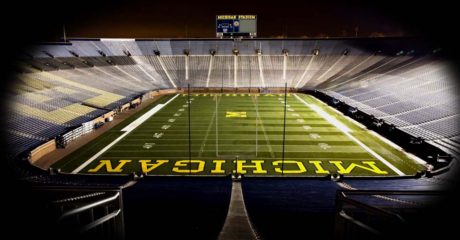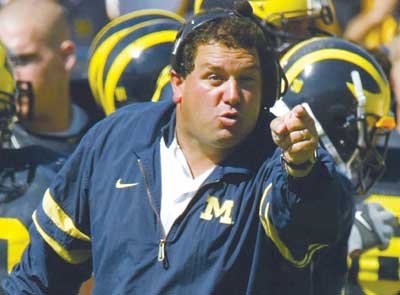Who fits and who doesn’t?
 |
| Quarterback Denard Robinson might struggle in a Brady Hoke offense |
After Lloyd Carr retired in 2007, Rich Rodriguez was hired and struggled to turn Carr’s pro-style personnel into a spread-style offense. Steve Threet and Nick Sheridan didn’t light the world on fire in 2008, and Tate Forcier was decent for a freshman in 2009. But the quarterbacks and other offensive players didn’t hit their Rodriguez-level spread until 2010, when Denard Robinson temporarily vaulted into the lead of the Heisman Trophy race. That leap was short-lived, since Rodriguez was ousted and replaced by Brady Hoke in January 2011, signifying a return to a pro-style offense.
I really had no reason to watch or study San Diego State University’s offense during the football season, but I’ve since watched some highlights and read some accounts of Hoke’s offensive schemes. Since no assistant coaches have been announced yet, it’s impossible to say for sure what schemes will be run. However, here are some thoughts based on what I’ve seen from SDSU’s 2010 offense.
It’s Michigan all over again. Lloyd Carr-style Michigan, at least. Multiple tight end sets, two backs in the backfield, play action with deep posts, a little bit of shotgun spread, I-formation, etc. Yep. You’ve seen it before.
Quarterbacks. Both of SDSU’s quarterbacks were 6’4″-6’5″ and 210-215 lbs. This does not bode well for Denard Robinson, who is approximately 6’0″ and 193 lbs. Additionally, Robinson’s best asset is his ability to run, not to drop back and read defenses. My initial reaction is to expect that Robinson will transfer, perhaps to Pitt, where former Michigan offensive coordinator Calvin Magee has alighted. He could go to Pittsburgh, sit out 2011, and have two years of eligibility to play quarterback. In my opinion, the best chance Hoke has to retain Robinson is to make a pitch for Robinson to become a running back or wide receiver. I think most people realize that Robinson’s NFL future lies in a position other than QB, so perhaps Hoke can convince him to begin that position change now. The rumor is that Tate Forcier has flunked out of the University of Michigan, so that leaves sophomore/redshirt freshman Devin Gardner to helm Michigan’s offense. I do not expect Gardner that would look elsewhere, and he could potentially be a four-year starter for Hoke. Gardner is more suited to play in a pro-style offense than Rodriguez’s spread, in my opinion, so this could be a positive change for him.
Running backs. This might be partially due to the talent available at Ball State and San Diego State, but Hoke doesn’t seem to mind using smaller running backs. One might think that he would revert to the 6’1″, 220 lb. running backs that Michigan used to employ in the 1990s and early 2000s, but that won’t necessarily be the case. I think each of the running backs on the current roster should be compatible with Hoke’s offense if they so choose.
Fullbacks. Michigan fans shouldn’t necessarily expect the bruising, blocker-only fullbacks that Lloyd Carr often used. Don’t think Kevin Dudley or Obi Oluigbo. Think B.J. Askew. Senior John McColgan could fit here as a blocker, but guys like Stephen Hopkins or Michael Cox would likely be more effective.
Tight ends. Michigan’s current tight ends shouldn’t have a hard time fitting in with Hoke. He likes to involve the tight end in the passing game (SDSU’s starter had 29 receptions and averaged 11+ yards a catch), and both Kevin Koger and Brandon Moore are athletic, pass-catching types. Ricardo Miller has reportedly changed positions to become a tight end, as well.
Wide receivers. In the short-term, Michigan should be fine at wide receiver. Hoke ran a West Coast style offense that uses bigger wide receivers. The likes of Darryl Stonum, Roy Roundtree, Je’Ron Stokes, D.J. Williamson, Jerald Robinson, and Jeremy Jackson should be fine. A couple of those guys aren’t exactly big, but they’re big enough and the top few guys are good enough to be successful. Martavious Odoms played outside in 2010, even though he’s more of a slot receiver. I do think Odoms could be a factor at WR because of his athleticism, blocking, and chutzpah, but he’s probably not the type of wideout that Hoke will recruit.
Slot receivers. Yeah, this is the position that will likely be phased out at Michigan. That’s not to say that we should expect Jeremy Gallon, Terrence Robinson, Kelvin Grady, or Drew Dileo to get cut. Every team out there seems to be able to use one or two of those types of guys to return punts and kicks, be a change-of-pace runner, or play in the slot. But there won’t be a need to keep so many of those types of kids on the roster. I wouldn’t be surprised to see some attrition from this position. I hope that none of these guys transfer, so don’t take this the wrong way, but it might make sense for a guy like Gallon or Robinson to go elsewhere. Gallon would have two years of eligibility remaining since he redshirted already; Robinson would only have one if he went to an FBS school, but he could play immediately in the FCS.
Offensive line. Michigan’s offensive linemen beefed up for the 2010 season, and I don’t think the transition will be much of a problem for them. We might see them adding a little more bulk for 2011 – especially Taylor Lewan – but it’s not like Rich Rodriguez was playing 260-pound linemen. Michigan might be a little undersized at center for a couple years, but David Molk is the strongest offensive lineman on the team and Christian Pace should have another year to add weight. But guys like Lewan, Patrick Omameh, Ricky Barnum, Elliott Mealer, and Rocko Khoury should be just fine.
Summary. Offensive attrition should be minimal as far as numbers go. Michigan might lose a quarterback, and I would understand if a running back/slot guy or two decided to try his hand elsewhere, but the transition from Rodriguez’s spread to Hoke’s pro-style offense shouldn’t be as much of a culture shock as Carr-to-Rodriguez. However, just looking at the quarterback position, the performance might suffer in the short-term while Hoke hones the skills of whichever quarterback(s) sticks around.




